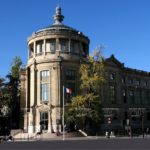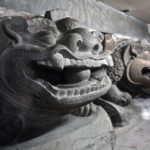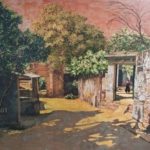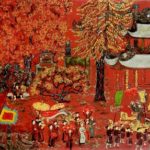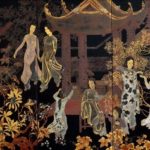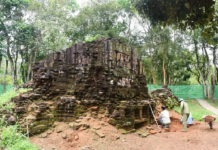With war being a topic that consumes everyone’s thoughts, Tâm has utilized his artistic talent to express his inner conflicts and emotions surrounding it. Through his art, he strives to portray the grim reality and atrocities he experienced during war, while also capturing the essence of everyday life and the humanity within it.
The current owner of the collection shared their fascination with Vietnamese history and art as a long-term expat in Saigon. They were particularly captivated by Tâm’s ability to rapidly sketch even in the most adverse conditions, effectively capturing a moment in time.
Born into a revolutionary family, Tâm joined the August 1945 Revolution led by the Viet Minh as a teenager, fully embracing the cause for freedom and independence from Japanese fascists and French colonialists.
During the first Indochina War (1946-54), Tam became involved in the resistance against the French by joining the publicity and information division. This was his initial introduction to using art as a means of expressing emotions.
The division held three exhibitions before Tam attended a six-month painting course in the jungle in 1948. During this time, he created wall paintings that celebrated the resistance movement, serving as a form of intimidation for nearby French military units. As a result, he was appointed to the Information Office in Hung Yen Province, where he began his lifelong passion for art by creating posters.
In 1950, he joined the Vietnam People’s Army, where he not only served as a soldier but also as a war reporter and artist for the Quyết Thắng newspaper.
In 1954, Tam took part in the Battle of Đien Bien Phu, where he lived on the front lines and documented his experiences through sketches and reports. His drawings earned him third place in the National Art Exhibition in Hanoi the following year when the resistance government took control of the city from the French.
He then continued his studies at the Vietnam Fine Arts College in Hanoi and worked as an artist and war correspondent for the Military Images magazine, Military Literature and Art magazine, and the People’s Army newspaper.
During the anti-American war, he traveled to the southern battlefields, documenting his experiences through writing and painting along the Ho Chi Minh Trail, in Khe Sanh, Quang Tri, Da Nang, and during the Sai Gon liberation campaign.
Despite working under challenging circumstances, Tâm managed to preserve the majority of his paintings and sketches by sending them back to Hanoi for safekeeping.
Reflecting on his time at Khe Sanh, Tam shared, “I did the watercolors right there at the battle, using a pen with watercolor. The idea was to not spend too much time in one place, so I would usually add the pen later on. When I traveled around the country and there was no intense fighting, I had more time to sketch carefully. I was accompanied by a photographer, which proved very useful. When I forgot details, I could reference his pictures and fill in the gaps. I used various materials, including watercolor, pen, and pencil – whatever I could find.”
Tam played a pivotal role in founding the Vietnam Fine Arts Association in 1957 and was later recognized for his outstanding contributions to Vietnamese art. In 1978, he was appointed the Director of the Military Fine Arts Workshop (later merged into the Military Museum).
During his tenure, he organized art exhibitions and taught fine arts. After retiring from the army with the rank of Colonel in 1989, he moved to Ho Chi Minh City, dedicating his time to creating artworks that reflected his life during the resistance wars. He used a range of materials such as oils, silk, watercolor, pencil, and pen.
His diary entries from the later years of his life, along with a collection of sketches, were compiled into the book “Drawing Under Fire: War Diary of a Young Vietnamese Artist,” published in 2005. Tâm is widely regarded as one of the most influential Vietnamese artists of his time.
Werner Freundel, the director of Chorley, spoke about the series of eight drawings being offered at auction, praising Tam’s impressionistic artwork that provides a glimpse into the realities of war and daily life on the battlefield. These artworks are extremely rare and rarely seen at auction.
The series includes highlights such as “Study of a Young Female Soldier” in pen and ink, “Soldiers Embarking on a Boat” in pen and ink, “Villagers and Soldier in a Landscape” in watercolor, “Figures Sitting Around a Pot” in pen and ink, “Saigon, Army Tank #2” in pen and ink, “Days Following the Footsteps of the Enemy” in watercolor over traces of pencil on paper, and “Barracks Scene” in pencil on paper.
Vietnamese artworks to be auctioned online
A total of 143 artworks by Vietnamese artists in different generations will be auctioned worldwide on June 27 via the Drouot Digital platform in Paris.


